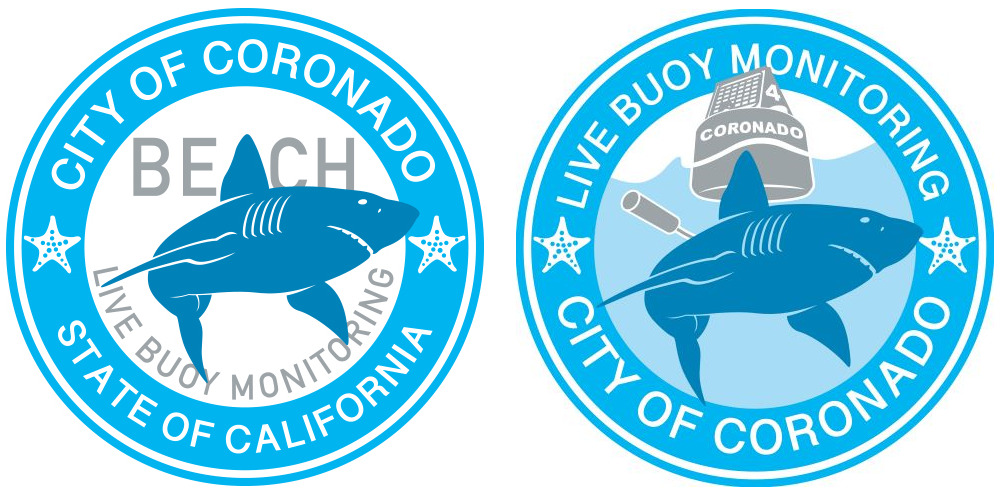By Phil G. Garn
Coronado beach patrons ashore and in the water have been consistently sighting the dorsal and caudal or tail fin of a juvenile white shark cutting through the sea’s surface since at least Sunday (September 19) cruising up and down the beaches from the annexed beach Boundary Fence at NAS North Island all the way down to the Naval Amphibious Base. While there has been a documented aggregation of primarily juvenile white sharks in Coronado waters for many months, the lifeguards and public have not observed such a consistent and highly visible presence with the classic dorsal fin and tail knifing through the water. Typically, the glimpses have been fleeting or short duration. The Coronado Beach Lifeguards have conducted further investigation observing that the seven-foot female has been hooked and is trailing about twenty feet of fishing line and is hosting an injury in the area of the caudal keel area near the tail.
I asked Dr. Chris Lowe head of the California State University Long Beach Shark Lab about the injured shark. Dr. Lowe related he has seen footage provided by our Coronado Beach Lifeguards of the animal. It is a seven-foot female that was previously tagged in Del Mar. From dip cam (camera) footage, Dr. Lowe said he observed large hook in the shark’s mouth and trailing about 20 feet of line and there is also an injury near the tail which appears to have been caused by heavy tackle, what he referred to as “a line wound.” Dr. Lowe does not believe that the wound is lethal and there was a possibility that the hook would rust out of the shark’s mouth over time. Carbon or mild steel hooks without an additive anodized coating, generally take a few weeks. Alternatively, stainless-steel hooks such as Martensitic stainless-steel hooks, may take several months or longer. He said he and his team at Shark Lab have encountered about six animals with line wounds.
It appears that individual(s) are using heavy duty fishing tackle to hook the sharks, likely at night and against the law. Dr. Lowe believes that they are probably eating the shark or passing it off as Mako or another unprotected shark species commercially. He did not believe there was a “black market” for white sharks in particular, and the animals are too rare for commercial farming or finning. Finning is the practice of catching sharks particularly more common blue, bull, black tip sharks and cutting the fins off for the Asian market while discarding the rest of the animal, oftentimes while the animal is alive letting the dismembered living carcass sink and drown. Dr. Lowe and his team are working with Fish and Game to go after people who are illegally catching white sharks. He said if a sport fisherman catches and releases an animal that is not necessarily a crime, and it is hard to know if the animal would survive after being released. Dr. Lowe said from time-to-time gill netters will catch white sharks, and if they haul one in it is not a crime – because it was not their intended catch – and they can keep the dead animal along with the rest of the catch for sale. He said gill netters generally do not want people to know that they have caught these specific animals (same thing with marine mammals.) Dr. Lowe did say it was very suspicious that Coronado’s shark monitoring buoy has just recently gone missing, coincidence? If anyone has information about the single-stationary, static monitoring buoy, please contact the Coronado Beach Lifeguards 619-522-7346.
Currently Sea World is coordinating a rescue/observation attempt and is bringing in other agencies thanks to the efforts of our Lifeguards and a number of concerned citizens. With decades of experience dealing with other injured protected marine animals from dolphins, seals and sea turtles to sea birds as well as wildlife enforcement, it would be natural to assume there would be protocols for dealing with an injured white shark. This is not the case, and our lifeguards are pioneering this work right now with Dr. Lowe and his team as well as other responsible agencies such as National Oceanic and Atmospheric Administration (NOAA) who has primary responsibility and allied partners including Sea World. This effort also would not have been possible without the foresight of our Beach Lifeguards, Fire Department and City leadership partnering with Dr. Lowe and the experts at California State University Long Beach Shark Lab months ago to explore the aggregation of white sharks here in Coronado as well as active citizens advocating for live buoy shark monitoring. One of the issues is getting permission from North Island (Navy) for flying the surveillance drone, that they use for scouting. The drone really helps locating the animals and has been used effectively in the white shark tagging operations. It takes approximately two weeks to obtain clearance from the Navy, which has to be submitted in advance. A Live Monitor Buoy system would certainly assist in this instance of an official investigation attempting to locate the tagged animal. Dr. Lowe also explained trying to untangle lines from sharks is very difficult. Again, if you see something, say something.





